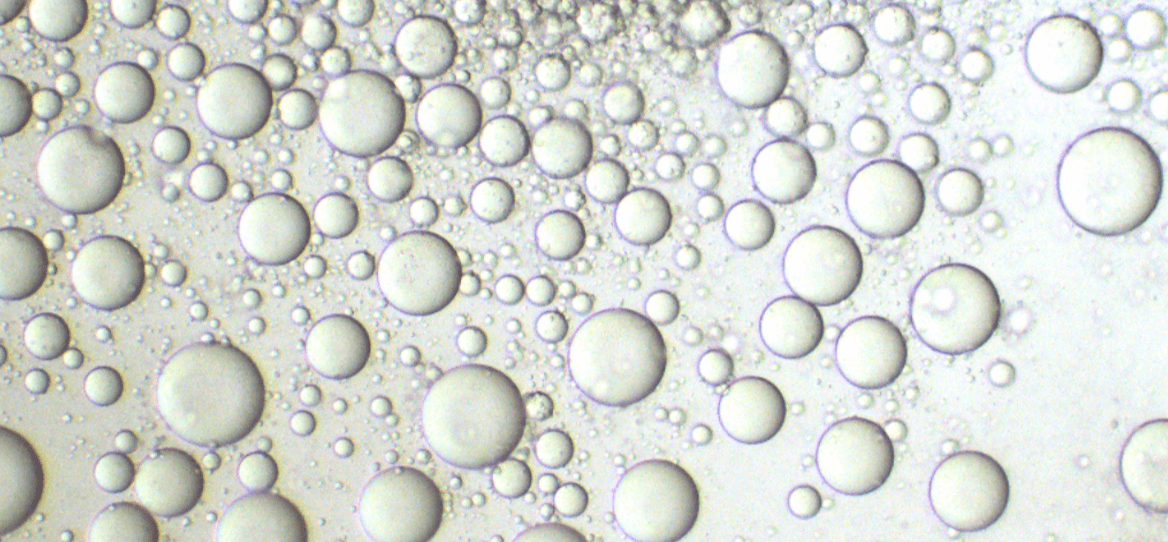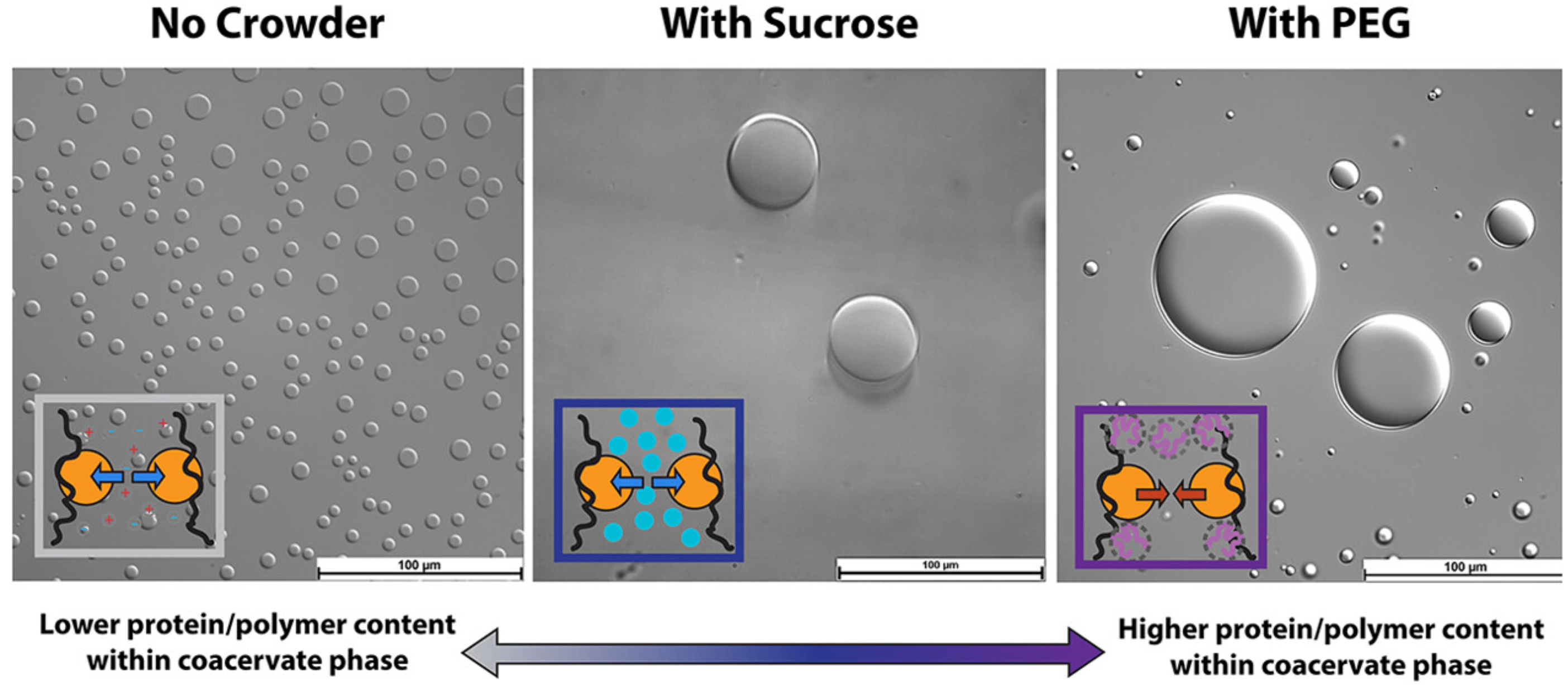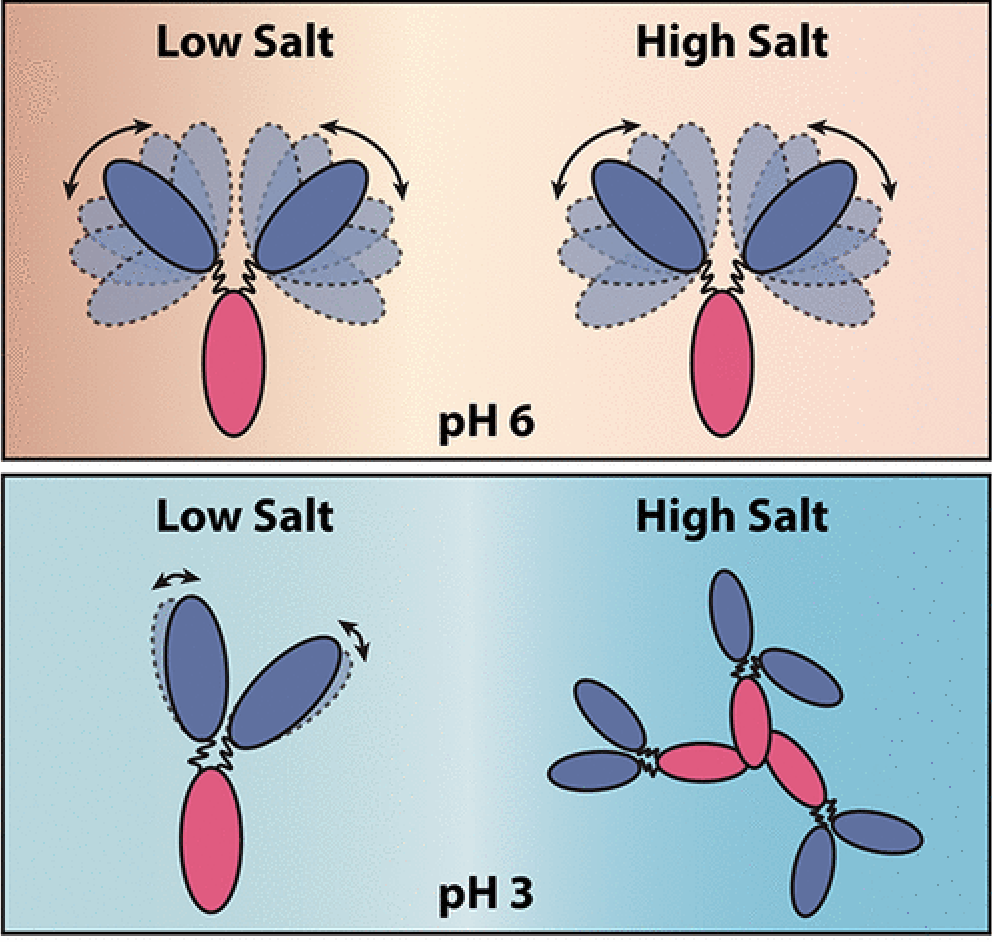Studying the structure and behavior of biomacromolecules in crowded environments
November 06, 2023

Bovine serum albumin, or BSA, molecules undergo liquid-liquid phase separation in a solution crowded with polyethylene glycol, or PEG, molecules. Phase-separated BSA molecules are enriched within the micron-sized liquid droplets.
Biomacromolecules are large molecules that are essential for life. They play a critical role in many biological processes and have applications in drug development and biotechnology. While biomacromolecules have significant therapeutic potential, they can be sensitive to various factors and conditions that affect their biological functions. Understanding these sensitivities is crucial for studying their functions and behaviors, as well as for developing effective therapeutic strategies.
Assistant Professor Amy Xu and her research group in the LSU Department of Chemistry are utilizing small-angle scattering, known as SAS, to study the structure and behavior of biomacromolecules in crowded environments. These environments range from cell-like settings where up to 40% of the space is occupied by various molecules, to concentrated biotherapeutic formulations where the protein concentration can reach as high as 200 mg/mL. The goal of their research is to deepen the understanding of the roles biomacromolecules play in living cells and to enhance the design of stable biotherapeutic formulations.
"Small-angle scattering, including small-angle X-ray and neutron scattering, is a novel and powerful characterization technique that allows us to examine structures across a broad range of length scales, from just a few nanometers, such as the size of a single protein, to hundreds of nanometers, like the size of protein/polymer complexes," Xu said. "Additionally, with the advanced sample environment developed at national X-ray and neutron facilities, we can measure our samples under extreme conditions, such as high pressure, cryogenic temperatures, and even with shear. This versatile capability is unique to SAXS and SANS measurements."

Protein/polymer complex coacervates formed under various crowding conditions exhibit distinct physical properties. These differences arise from the effects of specific crowding agents on the conformation and behavior of individual protein and polymer molecules.
– Biswas, S., Hecht, A. L., Noble, S. A., Huang, Q., Gillilan, R. E., & Xu, A. Y. (2023). Understanding the Impacts of Molecular and Macromolecular Crowding Agents on Protein-Polymer Complex Coacervates. Biomacromolecules. CC-BY 4.0
One area the Xu research group is focusing on is the use of SAS to investigate the phase behavior of protein/polymer complexes in crowded, cell-like environments and its implications for the formation of membraneless organelles, or MLOs, in living cells.
Proteins and polymers can undergo liquid-liquid phase separation under specific solution conditions, a process referred to as complex coacervation. When observed under a microscope, complex coacervates appear as micron-sized liquid droplets.
Recent research has shown that intrinsically disordered proteins and nucleic acids can also undergo liquid-liquid phase separation within living cells, leading to the formation of organelles that lack surrounding lipid membranes, i.e., MLOs. These organelles play crucial roles in processes such as RNA processing, stress response, cellular signaling, and the regulation of biochemical reactions.
To better understand the impacts of a crowded intracellular environment on the behavior and interactions of biomolecules involved in MLO formation, Xu and group members Shanta Biswas, Alison Hecht, and Sadie Noble examined the physical properties of a model protein-polymer complex coacervates formed in the presence of two different crowding agents: sucrose and polyethylene glycol. By utilizing SAS, they were able to understand the impact of crowding on complex coacervation and illuminate the formation and characteristics of coacervates in relation to MLOs.1
"SAXS allowed us to observe variations in macroscopic properties of coacervates formed in various crowded environments at the molecular scale," said Xu. "Understanding the phase behavior of biomacromolecules in crowded cellular environments provides more insights into the functions, dynamics, and regulatory mechanisms of these organelles, which play a pivotal role in various cellular processes."
The Xu research group is also utilizing SAS in combination with various biophysical techniques for the advanced characterization of monoclonal antibodies.

The flexibility and domain-domain interactions of mAb molecules are significantly influenced by the solution pH and ionic strength, which in turn determine their physical stability in concentrated formulations.
– Xu, A. Y., Blanco, M. A., Castellanos, M. M., Meuse, C. W., Mattison, K., Karageorgos, I., Hatch, H. W., Shen, V. K., & Curtis, J. E. (2023). Role of Domain-Domain Interactions on the Self-Association and Physical Stability of Monoclonal Antibodies: Effect of pH and Salt. The Journal of Physical Chemistry. B, 127 (39), 8344–8357. CC-BY 4.0
Monoclonal antibodies, or mAbs, make up a major class of biopharmaceuticals and are considered effective treatments for medical conditions, including cancers, immune disorders, and infections. However, they are subject to instability due to various environmental factors.
Xu and collaborators from the National Institute of Standards and Technology, Merck Research Laboratories, and Malvern Panalytical, investigated the conformational flexibility and protein–protein interactions, or PPI, of a model mAb molecule under near-neutral and acidic conditions.2
"The findings from this study reveal that the flexibility of mAb molecules is greatly influenced by solution pH. Our results demonstrate that increased flexibility in mAbs enhances their stability in solution. Conversely, when mAbs exhibit reduced flexibility, domain-domain interactions between Fc fragments can result in the mAb molecules assembling into the undesired higher-molecular-weight species," Xu said. "These insights are essential for improving the design and stability of upcoming biotherapeutics."
For her recent work in characterizing protein stability in crowded environments, Xu will chair the Biotherapeutic Developability and Stability session at the American Chemical Society Spring 2024 Meeting in New Orleans, March 17-21, 2024. The session will provide conference attendees an opportunity to gain in-depth knowledge, current studies, and a network of experts in the area of formulation and stabilization of biotherapeutics.
Amy Xu received her Bachelor of Science in 2009, Bachelor of Science, 1st Class Honours in 2012, and her Ph.D. in 2016 from the University of Auckland, New Zeeland. She completed post-doctoral research fellowships at the University of Massachusetts Amherst and then the National Institute of Standards and Technology / University of Maryland. In the fall of 2020, Xu joined the LSU chemistry department as an assistant professor.
To learn more about Assistant Professor Amy Xu and the work of her research group, visit their group page.
- Biswas, S., Hecht, A. L., Noble, S. A., Huang, Q., Gillilan, R. E., & Xu, A. Y. (2023). Understanding the Impacts of Molecular and Macromolecular Crowding Agents on Protein-Polymer Complex Coacervates. Biomacromolecules.
- Xu, A. Y., Blanco, M. A., Castellanos, M. M., Meuse, C. W., Mattison, K., Karageorgos, I., Hatch, H. W., Shen, V. K., & Curtis, J. E. (2023). Role of Domain-Domain Interactions on the Self-Association and Physical Stability of Monoclonal Antibodies: Effect of pH and Salt. The Journal of Physical Chemistry. B, 127 (39), 8344–8357.